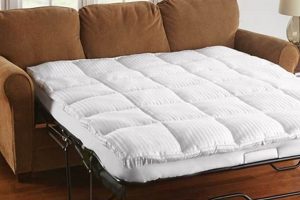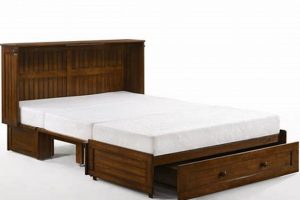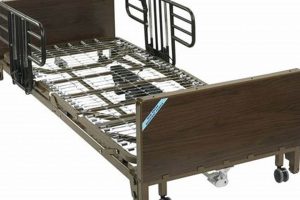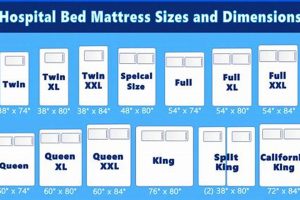Specialized support surfaces designed to alleviate concentrated force on bony prominences are crucial in the prevention and management of pressure injuries. These surfaces redistribute the patient’s weight, minimizing areas of high pressure that can lead to tissue damage and ulceration. They are typically constructed from materials such as foam, air, or gel, each offering varying degrees of pressure reduction and patient comfort.
The utilization of these supportive aids offers significant clinical advantages, contributing to improved patient outcomes and reduced healthcare costs. By reducing the risk of pressure injury development, they minimize the need for extensive wound care, pain management, and potentially, surgical intervention. Their historical development has been driven by the growing understanding of pressure injury etiology and the need for effective preventative strategies in at-risk patient populations.
The following sections will delve into the specific types of these support surfaces available, examining their mechanisms of action, clinical applications, selection criteria, and guidelines for proper use. This comprehensive overview aims to provide clinicians and caregivers with the knowledge necessary to make informed decisions regarding pressure injury prevention and management.
Guidelines for Optimized Use
The effective implementation of pressure-reducing support surfaces is paramount for mitigating the risk of pressure injuries. Adherence to established protocols and a thorough understanding of the technology involved are essential for maximizing patient benefit.
Tip 1: Conduct a Comprehensive Risk Assessment: Prioritize individuals at elevated risk for pressure injury development. Employ validated risk assessment tools, such as the Braden Scale, to identify factors like immobility, incontinence, nutritional deficiencies, and sensory deficits. This informs the appropriate selection and application of the intervention.
Tip 2: Select the Appropriate Surface: Choose a product specifically designed to address the patient’s individual needs and risk factors. Consider factors such as weight capacity, level of immobility, presence of existing pressure injuries, and microclimate control features. Consult with a wound care specialist or healthcare professional to make an informed decision.
Tip 3: Ensure Proper Inflation and Function: For air-filled models, meticulously verify inflation levels according to the manufacturer’s instructions. Regularly inspect the surface for leaks, damage, or malfunction. An improperly inflated or damaged surface will not provide adequate pressure redistribution.
Tip 4: Implement Repositioning Schedules: While supportive surfaces reduce pressure, they do not eliminate the need for regular repositioning. Adhere to a scheduled turning protocol, typically every two hours, to further alleviate pressure on bony prominences. Document repositioning efforts meticulously.
Tip 5: Monitor Skin Integrity: Conduct daily skin assessments to identify early signs of pressure injury development. Pay particular attention to bony prominences such as the sacrum, coccyx, heels, and trochanters. Early detection allows for timely intervention and prevents further tissue damage.
Tip 6: Provide Patient and Caregiver Education: Educate patients and their caregivers on the importance of pressure injury prevention, proper surface usage, and skin care techniques. This empowers them to actively participate in the prevention process and recognize potential problems early on.
Tip 7: Maintain Optimal Microclimate: Excessive moisture can increase the risk of skin breakdown. Utilize moisture-wicking bedding and incontinence management strategies to maintain a dry and comfortable microclimate at the skin surface. Consider surfaces with microclimate control features for patients with excessive perspiration.
By implementing these guidelines, healthcare providers can optimize the effectiveness of pressure-reducing surfaces and significantly reduce the incidence of pressure injuries, leading to improved patient outcomes and reduced healthcare costs.
The following sections will address frequently asked questions and explore emerging technologies in the field of pressure injury prevention.
1. Pressure Redistribution
Pressure redistribution forms the foundational principle behind the effectiveness of specialized support surfaces designed to mitigate pressure injuries. The fundamental connection between a pressure mattress and pressure redistribution lies in the mattress’s ability to minimize concentrated force on bony prominences. By increasing the surface area over which a patient’s weight is distributed, the overall pressure exerted on any single point is reduced. This reduction is critical because sustained pressure impairs blood flow to the tissue, leading to ischemia, cell death, and ultimately, ulcer formation. Mattresses achieve this redistribution through various mechanisms, including segmented air cells, viscoelastic foam, and gel-infused layers, each designed to conform to the body’s contours and dynamically adjust to changes in position.
Failure to achieve adequate pressure redistribution provides a direct causal link to the development and progression of pressure injuries. For example, a patient confined to a standard hospital mattress, lacking specialized support, will experience significant pressure concentrations on the sacrum and heels. This sustained pressure can lead to observable skin breakdown within hours, particularly in individuals with compromised circulation or nutritional deficiencies. Conversely, a pressure mattress utilizing alternating air cell technology cyclically inflates and deflates cells, shifting pressure points and promoting intermittent tissue perfusion. This cyclic redistribution mimics natural body movement, enhancing circulation and preventing prolonged ischemia. Therefore, pressure redistribution serves as a direct and measurable determinant of a pressure mattress’s clinical efficacy.
In conclusion, pressure redistribution is not merely a feature of a pressure mattress; it is the defining characteristic. Its effectiveness dictates the mattress’s ability to prevent pressure injuries. Understanding this connection is vital for healthcare providers, enabling them to select appropriate support surfaces based on individual patient risk factors and mobility levels. Ongoing research continues to refine pressure redistribution technologies, seeking to optimize patient outcomes and minimize the burden of pressure injuries within healthcare settings.
2. Microclimate Control
Microclimate control is a critical attribute of specialized support surfaces used in pressure injury prevention. The term refers to managing temperature and moisture levels at the interface between the patient’s skin and the mattress s
urface. Elevated humidity and increased skin temperature are directly implicated in compromised skin integrity, making effective microclimate management a significant component of a pressure injury prevention strategy. Failure to adequately address this microenvironment exacerbates the risk of maceration, friction injury, and bacterial colonization, all of which contribute to pressure injury formation or impede healing. Mattresses incorporating features like breathable fabrics, airflow channels, or active cooling systems are designed to mitigate these adverse effects. For instance, a patient with excessive perspiration, when placed on a standard mattress lacking these features, will exhibit increased skin moisture and a higher risk of skin breakdown compared to a patient using a mattress with integrated moisture-wicking and ventilation technologies.
The practical application of microclimate control manifests in various mattress designs. Some surfaces utilize specialized fabrics that promote air circulation and wick away moisture from the skin’s surface. Others incorporate low air loss (LAL) systems, which gently circulate air through the mattress, creating a cooling effect and reducing humidity. Advanced systems integrate both LAL and temperature control, allowing for precise adjustment of the microclimate based on the patient’s individual needs. The selection of a mattress with appropriate microclimate control features necessitates a comprehensive patient assessment, considering factors such as perspiration levels, incontinence, and environmental conditions. Proper bedding choices, such as moisture-wicking sheets, further enhance the effectiveness of microclimate management.
In summary, the relationship between microclimate control and pressure injury prevention is undeniable. The ability to regulate moisture and temperature at the skin-mattress interface is a critical factor in maintaining skin integrity and reducing the risk of pressure injury development. While pressure redistribution remains a cornerstone of pressure injury prevention, effective microclimate management provides a complementary and essential element in comprehensive patient care. Further research continues to explore innovative approaches to microclimate control, aiming to optimize patient comfort and minimize the incidence of pressure injuries.
3. Material Composition
The constituent materials of a support surface exert a significant influence on its efficacy in preventing pressure injuries. Material selection dictates factors such as pressure redistribution capability, microclimate control, durability, and cleanability all critical to the performance of these medical devices.
- Foam Density and Type
The density and type of foam employed directly correlate with the mattress’s ability to redistribute pressure. High-density foams offer greater support but may lack conformability. Viscoelastic foams, such as memory foam, mold to the body’s contours, reducing pressure concentrations. Open-cell foams promote airflow, aiding in microclimate management. The optimal choice depends on the patient’s weight, mobility, and risk factors. For instance, a bariatric patient requires a higher-density foam than a frail, low-weight individual.
- Air Cell Configuration and Material
In alternating pressure mattresses, the configuration and material of the air cells are paramount. The cell design determines the pressure redistribution pattern and the frequency of pressure changes. The material, often polyurethane or PVC, must be durable, airtight, and resistant to cleaning agents. A poorly designed air cell system may create localized pressure points, negating the intended benefits.
- Cover Fabric Properties
The cover fabric plays a vital role in microclimate control and hygiene. Waterproof but breathable fabrics, such as polyurethane-coated nylon, protect the mattress core from fluid penetration while allowing moisture vapor transmission. This minimizes maceration risk. Antimicrobial treatments on the fabric surface inhibit bacterial growth, reducing the risk of infection. Rough or non-breathable fabrics can contribute to friction and shear, increasing the risk of skin breakdown.
- Gel Polymer Composition
Gel-infused mattresses utilize polymers to enhance pressure redistribution and provide a cooling effect. The type and concentration of the gel influence its viscosity, conformability, and thermal properties. Higher gel concentrations generally provide better pressure redistribution but may reduce airflow. The gel polymer must be non-toxic, hypoallergenic, and resistant to degradation over time.
These material characteristics collectively determine the suitability of a pressure mattress for a given patient population. The optimal choice involves a careful consideration of the individual’s specific needs and risk factors, ensuring that the selected surface provides adequate pressure redistribution, microclimate control, and durability to effectively prevent pressure injuries.
4. Weight Capacity
Weight capacity stands as a critical specification in the selection of support surfaces intended for pressure injury prevention. The designated weight limit directly impacts the effectiveness of pressure redistribution, a core function of these mattresses. Exceeding the stated weight capacity compromises the structural integrity of the mattress, negating its ability to evenly distribute the patient’s mass across the surface. The resultant effect is concentrated pressure on bony prominences, effectively rendering the mattress ineffective and potentially increasing the risk of pressure injury formation. For example, a patient weighing 350 pounds positioned on a mattress with a maximum weight capacity of 250 pounds will not benefit from the intended pressure relief. The mattress will deform, leading to bottoming out and localized pressure points on the sacrum, coccyx, and heels. This can quickly lead to tissue ischemia and ulcer development.
Beyond the immediate risk of pressure injury, exceeding weight capacity can also lead to premature degradation of the mattress materials. Overstressed foam, air cells, or gel components can fail, reducing the lifespan of the product and necessitating replacement. This has direct economic implications for healthcare facilities. Furthermore, using a mattress beyond its weight limit creates a safety hazard for both the patient and caregivers. A compromised support surface can lead to instability during patient transfers, increasing the risk of falls. Regular inspection of mattresses and adherence to manufacturer guidelines are, therefore, essential for ensuring safe and effective use.
In summary, understanding and respecting the weight capacity of pressure-redistributing mattresses is paramount for patient safety and pressure injury prevention. Selecting a mattress that accommodates the patient’s weight is a fundamental step in providing appropriate support and minimizing the risk of tissue damage. Failure to do so not only undermines the therapeutic benefits of the mattress but also creates potential safety hazards and increases healthcare costs. Regular training and clear protocols for weight capacity verification are crucial for ensuring optimal patient outcomes.
5. Patient Mobility
Patient mobility is a primary determinant in the selection and utilization of pressure-redistributing mattresses. The degree to which an individual can independently reposition significantly influences their susceptibility to pressure injury development, directly impacting the type of support surface required.
- Frequency of Repositioning
Patients with limited mobility require more frequent manual repositioning, typically every two hours, to alleviate pressure on bony prominences. While specialized mattresses aid in pressure redistribution, they do not eliminate the need for scheduled turning. The inability to self-reposition necessitates a higher-specification mattress, often with alternating pressure capabilities, to compensate for the lack of spontaneous movement. Infrequent repositioning on an inadequate surface substantially elevates pressure injury risk.
- Range of Motion Limitations
Contractures, paralysis, or pain can significantly restrict a patient’s ability to shift weight and relieve pressure. Limited range of motion demands a highly conformable mattress that adapts to the patient’s unique body shape and minimizes shear forces. For example, a patient with hip flexion contractures requires a mattress that accommodates the altered anatomical position without creating pressure points. Standard mattresses may exacerbate discomfort and increase the likelihood of tissue damage.
- Assisted Transfers and Bed Mobility
The level of assistance required for transfers and bed mobility impacts the choice of mattress. Patients requiring full assistance are at greater risk during these maneuvers, as shear forces can occur if the mattress surface does not facilitate smooth movement. Mattresses with low-friction surfaces minimize shear during transfers, reducing the likelihood of skin tears or friction burns. Moreover, the mattress must provide a stable base for caregivers to safely assist with repositioning and transfers.
- Neurological Impairment and Sensory Deficits
Neurological conditions or sensory impairments can diminish a patient’s awareness of pressure and discomfort, increasing their vulnerability to pressure injuries. Individuals with impaired sensation may not recognize the need to shift their weight or report discomfort, leading to prolonged pressure exposure. In such cases, a proactive approach with a high-performance mattress and frequent skin assessments is essential to prevent pressure ulcer formation.
In conclusion, patient mobility is inextricably linked to the effectiveness of pressure mattresses. Assessing a patient’s mobility status is a fundamental step in selecting the appropriate support surface and implementing a comprehensive pressure injury prevention plan. Understanding the interplay between mobility limitations and mattress characteristics allows clinicians to tailor interventions to individual patient needs, ultimately reducing the incidence of pressure-related complications.
Frequently Asked Questions
The following section addresses common inquiries regarding the use of specialized support surfaces, specifically pressure mattresses, in the context of pressure injury prevention and management.
Question 1: What distinguishes a pressure mattress from a standard hospital mattress?
Pressure mattresses are engineered to redistribute pressure, minimizing concentrated force on bony prominences. Standard mattresses typically lack this feature, potentially leading to sustained pressure and tissue ischemia. Pressure mattresses utilize materials such as specialized foam, air cells, or gel to achieve pressure redistribution.
Question 2: How often should a pressure mattress be inspected for proper function?
Pressure mattresses, particularly those with air cells, should be inspected at least once per shift. Air pressure, integrity of the surface, and the presence of any leaks or damage must be assessed. Malfunctioning mattresses compromise pressure redistribution capabilities.
Question 3: Does the use of a pressure mattress eliminate the need for patient repositioning?
No. While pressure mattresses aid in pressure redistribution, they do not negate the necessity of scheduled repositioning. Regular turning, typically every two hours, remains crucial for preventing prolonged pressure on vulnerable tissues.
Question 4: Are pressure mattresses suitable for all patients?
Pressure mattress selection must be based on a comprehensive patient assessment, considering factors such as weight, mobility, skin integrity, and risk factors for pressure injury development. Not all pressure mattresses are appropriate for all patients. Consultation with a wound care specialist may be advisable.
Question 5: What role does microclimate play in pressure injury prevention when using a pressure mattress?
Microclimate control, managing temperature and moisture at the skin surface, is a critical adjunct to pressure redistribution. Excessive moisture exacerbates skin breakdown. Pressure mattresses incorporating breathable fabrics or low air loss systems aid in microclimate management.
Question 6: How does weight capacity affect the performance of a pressure mattress?
Exceeding the weight capacity of a pressure mattress compromises its ability to effectively redistribute pressure. This can lead to bottoming out and concentrated pressure on bony prominences. Weight capacity should be a primary consideration during mattress selection.
The information provided addresses fundamental considerations regarding the utilization of pressure mattresses in pressure injury prevention. This knowledge aids in informed decision-making and optimal patient care.
The subsequent section will examine emerging technologies in the field of pressure injury prevention and management.
Conclusion
The preceding sections have explored the multifaceted aspects of pressure mattresses for bed sores, emphasizing the significance of pressure redistribution, microclimate control, material composition, weight capacity considerations, and the role of patient mobility. The effective deployment of specialized support surfaces represents a crucial component in a comprehensive pressure injury prevention strategy. Understanding the interplay of these factors enables informed decision-making, ultimately contributing to improved patient outcomes and a reduction in healthcare-associated costs.
Continued vigilance and adherence to established guidelines are paramount in mitigating the risks associated with pressure injuries. Further research and technological advancements promise to refine existing interventions and introduce novel approaches to pressure injury prevention. Prioritizing evidence-based practice and continuous quality improvement initiatives will be instrumental in minimizing the incidence of these debilitating conditions.






![Best Air Bed Double Mattress [Deals] For Comfy Nights! Organic & Natural Mattress Buyer’s Guide: Non-Toxic Sleep Solutions Best Air Bed Double Mattress [Deals] For Comfy Nights! | Organic & Natural Mattress Buyer’s Guide: Non-Toxic Sleep Solutions](https://mattressworldpa.com/wp-content/uploads/2025/07/th-7086-300x200.jpg)
